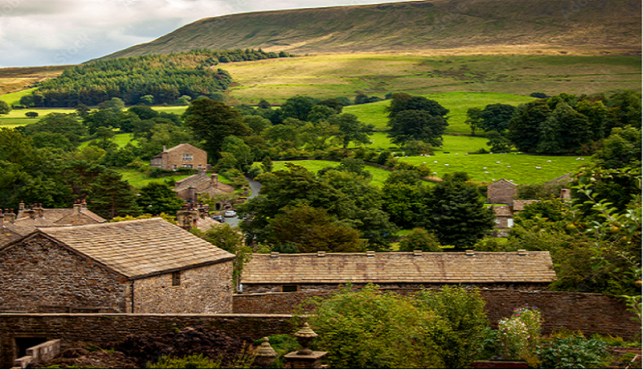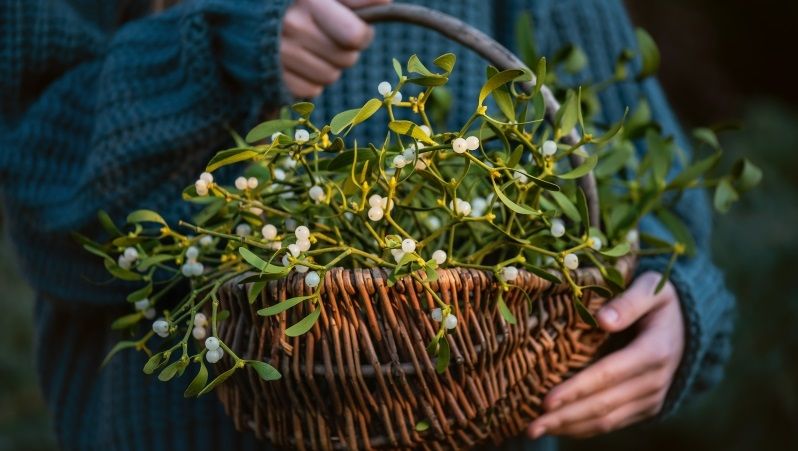
Take 5… Homes with Trees
The glory of trees can be celebrated in these 5 properties for sale across the country: enjoy the different feel from copses and ancient woodlands that celebrates the diversity of tree species across the British Isles.


Have you ever paused to wonder where do Christmas traditions come from and how your favourite traditions started? From the Yule Log to the romantic mistletoe, Strutt & Parker discloses the long-forgotten stories behind Britain’s best-loved holiday traditions.
A classic, child-friendly alternative to the boozy Christmas cake, this chocolatey, icing-dusted sponge makes an appearance on many festive family menus. But before cutting that first slice, let’s dig into the meaning behind this log-shaped treat.
The word ‘Yule’ is an Old Norse (Scottish) term referring to a 12-day winter feast, later applied to Christmas. During this ancient celebration, the Celtic Druids believed that the sun stood still, and so throughout this time they burned an oak log to fight against darkness and give power to the sun. When the log was almost entirely ashes, the last piece would be saved to light the following year. As time went on, this tradition was immortalised in the form of the wonderful chocolate delicacy we enjoy today.
The generous Father Christmas we know and love today is actually a blending of two tales. The first is another Scottish story. Krampus, was primarily a European figure, who would arrive on Christmas Eve night to scare naughty children. The arrival of ‘Crom Dubh na Nollaig’ or ‘the dark crooked one of Christmas’ could be anticipated by the sound of wind howling in the chimney – a sound that children were told to fear.
Slightly closer to the Father Christmas of today is the story of Saint Nicholas, otherwise known as the Bishop of Myra, who dressed in the traditional fourth century bishop attire of red and white robes. Saint Nicholas was known for being kind to children and is today traditionally associated with the jolly figure of Christmas.
The name ‘Boxing Day’ originates from the 1800s when Queen Victoria was on the throne. On this day, the rich would put gifts in special Christmas boxes and give them to the poor, while servants also got the day off to go home and see their families.
Churches also contributed to this day of giving. Having collected money from churchgoers throughout the year, vicars would store donations in a moneybox, open it on Christmas Day and hand it out on Boxing Day. While this hasn’t stuck officially, some people still leave out ‘Christmas boxes’, in the form of extra money or treats for delivery drivers.
So many Christmas traditions come from the tree; from the baubles different families hang, to whether they use tinsel or not, the type of lights they use, what goes under it, and most importantly what goes at the top.
The tall fir tree itself has actually been a part of pagan winter traditions for many centuries, with Christians decorating evergreen trees with apples to represent the Garden of Eden. Eastern Europe first began using it as a Christmas tree in the festive way we do now, but it was Queen Victoria and Prince Albert, inspired by their German roots, who made it popular here. So much so that it then took off across the world, including the US, where it was weaved into popular culture.
Albert first shipped over a 26ft Nordmann Fir tree from Germany to Windsor Castle, where you can still visit today to view some of the best Christmas decorations the country has to offer.
People often say the true meaning of Christmas is not about the presents. While this is of course true, gift giving is still a real part of the history of Christmas, as already explained with the Christmas boxes. The truth is, it’s derived from lots of different stories from the past.
During the Pagan festival of Saturnalia, an ancient Roman festival and holiday in honour of Saturn, children were gifted wax dolls to represent sacrifices they believed Rome had given to Saturn in return for good harvests. This rather morbid tradition, contrasted with Saint Nicholas giving gifts to poor children, and the three wise men bringing presents to new-born baby Jesus (gold, frankincense, and myrrh), meant it evolved into the modern-day gift giving we see today.
While this tradition might have slightly more prominence in films, today this famous plant is intended for people to have their Christmas kisses under. However, have you ever wondered why we kiss under the mistletoe, when its history is quite the opposite?
Circling back to the Druids, the evergreen mistletoe plant with its cluster of pretty pearlescent white berries, used to be considered a sign of friendship. Because of this, the Christian church banned it in England. However, it later took a new lease of life when York Minster Church began to hold a particular ‘mistletoe service’ each winter. Legend has it town criminals would attend with a sprig of mistletoe to be pardoned for their faults and mistakes.
While mistletoe is more likely to be hung at pubs or Christmas parties, you might still spot it on some church altars during the festive period.
Perhaps one of the strangest traditions of them all, is that we leave out food and drink for Father Christmas, offering him refreshments to help ensure he has a comfortable journey.
But why do we do it? Many choose to leave milk and cookies out, which is often seen as a more American tradition, after becoming popular during the Great Depression. According to the History Channel, parents encouraged their children to leave out cookies to show that, despite economic hardship, you should be grateful for what you have and that giving is just as important as receiving.
Here in the UK, while we also leave milk and cookies biscuits out, our favourite gifts seem to be mince pies, sherry and a carrot for Rudolph. This could also be associated with the feast day of Saint Nicholas on 6 December, where children would leave food and drink out for the Saint and families would exchange them for gifts overnight.
Feeling festive? Explore our seasonal articles to help get you (and your home) in the Christmas spirit.